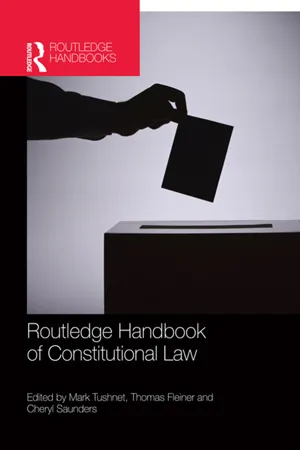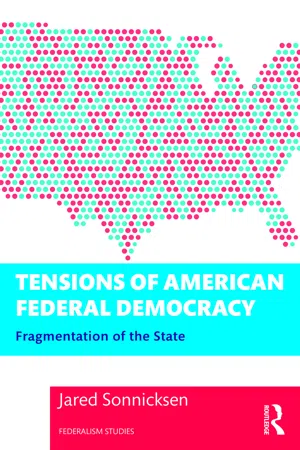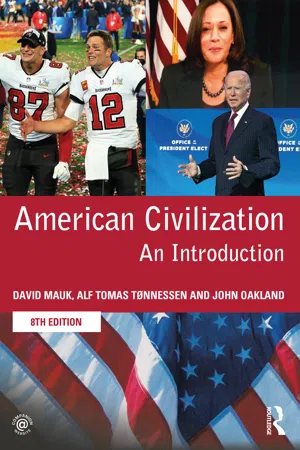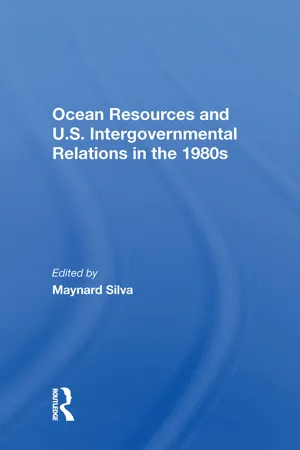Politics & International Relations
US Government Structure
The US government structure is based on a system of checks and balances among three branches: the executive, legislative, and judicial. The executive branch is headed by the President, the legislative branch is composed of the Senate and the House of Representatives, and the judicial branch is led by the Supreme Court. This separation of powers is designed to prevent any one branch from becoming too powerful.
Written by Perlego with AI-assistance
6 Key excerpts on "US Government Structure"
Learn about this page
Index pages curate the most relevant extracts from our library of academic textbooks. They’ve been created using an in-house natural language model (NLM), each adding context and meaning to key research topics.
- eBook - ePub
- Mark Tushnet, Thomas Fleiner, Cheryl Saunders, Mark Tushnet, Thomas Fleiner, Cheryl Saunders(Authors)
- 2013(Publication Date)
- Routledge(Publisher)
The American system is the classic presidential system. In the United States, the label ‘presidential’ should not be construed as implying that the constitution puts the President, the constitution’s executive authority, to the forefront at the expense of Congress (the legislative branch). When Woodrow Wilson, then a professor of political science, wrote an authoritative account of the régime in 1885, he called it ‘congressional government’ in order to emphasize (and deplore) Congressional prominence. This prominence has later waned, but the US model of government still relies on a balanced relationship between both branches.The core features of the presidential model, US style, can be expressed in the language of separation of powers. The constitution creates three ‘powers’ or three branches of government: the legislative function is devolved to Congress; the executive power to the President (and that institution alone); and the judicial power is ‘vested’ in the Supreme Court, and in ‘inferior Courts’ (s 1, art III). This vesting of powers, which takes place in the first three Articles of the Constitution and dominates understanding of it, is not absolute. Functions overlap. In part, this is because it is impossible to define functions absolutely—the interpretation of law necessarily involves some law-making; executing legislative programmes necessarily involves some law-making and adjudication of interests. In part, however, functions are shared to prevent any branch of government from monopolising power: it is, famously, a system of ‘checks and balances’. For example, the grant of legislative power to Congress is mitigated by the presidential power to veto laws, and the executive power of the President is tempered by the involvement of the Senate in certain appointments to the executive and in approving international agreements. Moreover, even though the requirements of justice are such that courts are expected to enjoy greater independence than the two other branches of government, there are some limits on the ‘separation’ of the judicial branch. Most notably, judges are chosen by the other two branches.The three branches of government are deprived of the means of institutional pressure that characterise parliamentary government. The separately elected President and Congress have independent legitimacy. Accordingly, the President cannot dissolve either House of Congress and, in turn, neither the House of Representatives nor the Senate can force the President to resign by way of a vote of no confidence. The President can be removed from office only through a deliberately complex process of ‘impeachment’ by Congress in which it is established that he or she has (or has not) been ‘guilty’ of ‘Treason, Bribery, or other high Crimes and Misdemeanors’. Certain aspects of this procedure replicate some features of criminal justice and, unlike the Queen of England, who enjoys full constitutional immunity, the US President is both subject to criminal liability and can be removed from office through the impeachment procedure. As far as the President is concerned, impeachment is better approached as a very specific instance of political accountability. The President cannot be removed merely because a majority (or even a super-majority) in Congress disapprove of his or her policies. Political disagreements between Congress and the President must be resolved by negotiation or, at worst, at the next scheduled election. Unlike votes of no confidence in a parliamentary government, impeachment does not sanction poor (but legal) political choices (‘maladministration’). Rather, it aims at protecting the constitution and the system of government against egregious behaviour that is likely to imperil the whole constitutional edifice and is perceived as a ‘breach of trust’. - Scott Dittloff(Author)
- 2018(Publication Date)
- Research & Education Association(Publisher)
Political theory also involves the philosophical and speculative consideration of the political world.American Government and Politics is a survey of the origins and development of the political system in the United States from the colonial days to modern times with an emphasis on the Constitution, various political structures such as the legislative, executive, and judicial branches, the federal system, political parties, voter behavior, and fundamental freedoms.Comparative Government is a systematic study of the structures of two or more political systems (such as those of Britain and the People’s Republic of China) to achieve an understanding of how different societies manage the realities of governing. Also considered are political processes and behavior and the ideological foundations of various systems.International Relations is a consideration of how nations interact with each other within the frameworks of law, diplomacy, and international organizations such as the United Nations.The Development of the Discipline of Political Science Early HistoryPolitical science as a systematic study of government developed in the United States and in Western Europe during the nineteenth century as new political institutions evolved. Prior to 1850, during its classical phase, political science relied heavily on philosophy and utilized the deductive method of research.Post–Civil War PeriodThe political science curriculum was formalized in the United States by faculty at Columbia and Johns Hopkins, who were deeply influenced by German scholarship on the nation-state and the formation of democratic institutions. Historical and comparative approaches to analysis of institutions were predominant. Emphasis was on constitutional and legal issues, and political institutions were widely regarded as factors in motivating the actions of individuals.- eBook - ePub
Tensions of American Federal Democracy
Fragmentation of the State
- Jared Sonnicksen(Author)
- 2022(Publication Date)
- Routledge(Publisher)
thinking in the box. This “box” has been inherited from the late 18th century. Its evolution has brought about far-reaching changes, but has remained complexly bound to and limited by its points of departure to this day.The US polity comprises a system of complex – i.e. multidimensional – and divided government as much as a highly diffuse and decentralized political order by predisposition. These structural conditions on their own are important. They are not, however, solely determinative. Even without formal constitutional change, the dynamics of governance, political contestation, and constitutional interpretation can take various directions and exhibit different patterns. Like any federal democracy in a modern, constitutional, and rule-of-law state, governments in the USA can cope with the tensions and navigate the multifarious divides inherent to its compound political order. However, they can also wind up intensifying the divisions and thus encumbering cooperation between branches and levels of government. Over time the latter particularly appears to recur, generating the overarching pattern of a limited state. I seek to make a case for why this is so.The US government in comparison
The USA is a peculiar case in multiple ways. While every system is special and in sum a unique case, the USA can be particularly difficult to categorize. As a simple initial illustration, the USA, taking the time since independence as a measure, is neither young nor old. As a nation, it tends to be considered a rather young one, especially compared with most other civilizations or peoples in the world. On the other hand, its constitution of 1789 and thus its system of government stands by most accounts as the oldest continuous republic in the world. The same could apply regarding continuity in democratic government. Most democratic systems in the world were not established or democratized until after World Wars I and II and in another wave after the Cold War. Yet looking at universal suffrage alone, the USA was behind a number of countries in introducing the right to vote for women. Moreover, the USA also practiced slavery within its own country longer than most modern states and, despite emancipation in the 1860s, did not even abolish racial segregation until the 1950s or secure equal voting rights until the 1960s. Hence, the USA represents a rather young democracy too. From another perspective, the USA belongs to the group of (post-)industrialized and OECD countries. It continues to lead globally in multiple technological, education, and research areas, and has the largest economy by gross domestic product in the world. At the same time, it demonstrates rather below-average performance of its welfare and healthcare systems. Other metrics would seem to place the USA outside the group of most developed countries entirely, evident in the notoriously high percentage of gun ownership and violence, but even more drastically the usage of capital punishment and appalling levels of incarceration. This already reveals much ambiguity. Whether these matters are explainable by political culture are surely open to debate. What is certain though, and more relevant here, is that they undoubtedly relate to politics and political systems, the constitution, and even the types of separation of powers. A brief view of the USA, more specifically from comparative government, provides an overall similarly ambivalent account. - eBook - ePub
American Civilization
An Introduction
- David Mauk, Alf Tomas Tønnessen, John Oakland(Authors)
- 2021(Publication Date)
- Routledge(Publisher)
Chapter 6 Political institutionsThe federal government
- Historical origins
- The constitutional framework
- The political parties
- The legislative branch
- The executive branch
- Presidential elections
- Campaign financing
- Reform the system?
- The judicial branch
- Exercises
- Further reading
- Websites
In an April 13, 2020, press briefing on COVID-19, Donald Trump said his authority as president was total. He argued that he could reopen the economy against the views of governors. Trump’s point of total authority is similar to his argument in his 2016 acceptance address at the Republican National Convention about the country’s challenges that “I alone can fix it.” In January of 2021, Trump was the first president in American history to be impeached by the House of Representatives for a second time. In 2019, no Republicans in the House had voted to impeach Trump after he had withheld congressionally approved foreign aid to Ukraine. Trump had demanded that the Ukrainian president announce an investigation of his political rival Joe Biden and his son Hunter. In 2021, however, ten Republicans joined all Democrats and impeached Trump for incitement of insurrection when Congress was attacked by an angry mob on January 6, resulting in the loss of five lives. The mob shared Trump’s view that the election had been stolen from him. Most commentators agree that this was the most serious domestic attack on the federal government since the Civil War.Stable political institutions have been essential in a nation of immigrants. Commentators feel that loyalty to the basic structures and principles of government acted as the cement that held together so large and diverse a nation. The US holds several records for political stability and longevity. It is the world’s oldest functioning democracy and also has the oldest written constitution and political party (the Democratic Party).Much has changed in American government and politics since the nation declared its independence. The Constitution of 1787 has endured because it has proven amenable to changing interpretations and important extra-constitutional elements. Political institutions in the US continue to be the subject of heated debate. In his inaugural address, President Joe Biden emphasized national unity and the importance of truth. He became president in the most difficult situation since Franklin Roosevelt assumed office in 1933. Referring to the vulnerability of federal institutions, President Biden proclaimed that “at this hour democracy has prevailed.” - Maynard Silva(Author)
- 2021(Publication Date)
- Routledge(Publisher)
1Models of American Intergovernmental RelationsThomas J. AntonDOI: 10.4324/9780429038624-1For many years, students of American federalism have struggled to develop parsimonious explanations for the joint activities of local, state, and national governments. To say that the struggle has been successful would be far too generous; our efforts continue to be confounded by the enormous variety and complexity of American politics. Nonetheless, I think it fair to say that we mave made significant progress. Although a dominant conceptual paradigm has not emerged, nor is a single paradigm likely to become dominant, we have begun to clarify major alternative approaches, and we are doing a great deal more systematic work designed to clarify these approaches. In this chapter I attempt to document these assertions by reviewing several important conceptual models of American federalism now in use. These models, I will suggest, reflect the legal and cultural context within which the political issue of federalism is debated. I will also suggest that they reflect considerable improvement in our ability to move beyond confusion to an appreciation of intergovernmental political behavior.The Federal Context
Federalism may be thought of as a system of rules for the division of public policy responsibility among a number of autonomous governmental agencies. These rules define the scope of authority available to the autonomous agencies--who can do what--and they provide a framework to govern relationships between agencies. The agencies remain autonomous, but they are also linked together by rules that govern their common activities.1Since all modern states include a large number of government agencies, it is perfectly legitimate to ask what differentiates federal systems from others. Even highly centralized governing systems, officially controlled by a single executive or a tiny committee, find it necessary to diffuse some authority to other agencies, particularly if public responsibility extends over a large physical territory. Once diffused, the pieces of authority available to other, noncentral, agencies allow them to act autonomously in many situations, regardless of the formal degree of system centralization.2 Similarly, states referred to as "unitary" typically operate with rules that assign formal responsibilities to a variety of subnational governments, as well as the central state agencies.3- eBook - ePub
- Cynthia Metcalf, Rhonda Atkinson(Authors)
- 2017(Publication Date)
- Research & Education Association(Publisher)
Analyze the guiding concepts, principles, and effects of U.S. foreign policy. The Constitutional Framework for Foreign PolicyThe Constitution lays out the institutional framework for foreign policy that places it under control of the federal government. The Founders divided responsibility for foreign affairs between the president and the Congress. The president, as the head of state, could appoint and receive ambassadors, sign treaties, and represent the United States abroad. Congress could declare war, but the president, as commander-in-chief, could actually wage the war. The president also had the authority to negotiate treaties that are then subject to the advice and consent of the Senate (two-thirds vote needed for approval). The president appoints key foreign policy and military officials as well as ambassadors, but the Senate must consent.The Theoretical Framework of International Relations The study of how nations interact with one another can be approached from a variety of perspectives, including the following:• A traditional analysis uses the descriptive process and focuses on such topics as global issues, international institutions, and the foreign policies of individual nation-states.• The strategists’ approach zeroes in on war and deterrence. Scholars in this camp may employ game theory to analyze negotiations, the effectiveness of weapons systems, and the likelihood of limited versus all-out war in a given crisis situation.• The middle range theorists analyze specific components of international relations, such as the politics of arms races, the escalation of international crises, and the role of prejudice and attitudes toward other cultures in precipitating war and peace.• A world politics approach takes into consideration such factors as economics, ethics, law, and trade agreements and stresses the significance of international organizations and the complexities of interactions among nations.The grand theory of international relations is presented by Hans J. Morgenthau in Politics Among Nations





